Udinese have enjoyed their best start to a Serie A season. The Bianconeri have won their last five games — a run of fixtures that includes two impressive victories over Inter Milan and Roma. They are currently lying third in the league and are the most in-form team in Serie A.
New boss Andrea Sottil — the father of current Fiorentina winger Riccardo Sottil — took charge of the team in the summer after leaving Ascoli by mutual consent. Sottil guided the Picchi to the Serie B playoffs last season.
The Stadio Friuli will be familiar territory for Sottil as he played for the club as a defender from 1999 to 2003, making 87 appearances.
In recent times, Udinese have recruited well. With signings such as Gerard Deulofeu, Roberto Pereyra, Ilija Nestorovski and youngsters Beto, Lazar Samardžić, and Becao they have a good mix of experience and youth that will help them challenge for the Champions League and Europa League places.
This article will be a tactical analysis of the tactics that Andrea Sottil has implemented at Udinese this season, and the role they have played in pushing the club towards the top end of the Serie A table.
Formation
In the seven games played so far, Sottil has set Udinese up in a 3-5-2 formation. Apart from a period in the match against Sassuolo, the 3-5-2 formation has been used all the time.
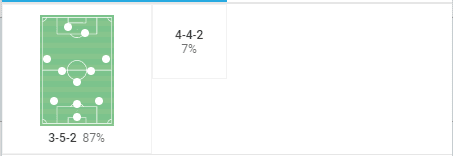
As a team, Udinese is aggressive in their pursuit of the ball. Once they win the ball, they look to hit the opposition with quick transitions, and they look to attack through the wide areas.
Although the 3-5-2 tactic is considered a primarily defensive system, the 3-5-2 formation that Sottil has implemented is proving to be effective for Udinese at the other end of the pitch as they have the joint best attack in Serie A, in terms of goals scored.
The 3-5-2 formation provides both good attacking and defensive balance. The formation gives up the wide areas by keeping a numerical advantage right through the centre of the pitch as Udinese does with the centre backs, the centre midfielders and two centre forwards. So, the team can keep it balanced at both ends as they transition fully between attacking in numbers and defending in numbers if the system is applied correctly.
Attacking Stages
This season, Udinese have favoured a defence-first and then counter-attacking approach under their new manager. They have been happy to go through a period of the game without possession, and then only look to regain it when their opponents are vulnerable presenting a greater opportunity to attack.
The amount of possession they have averaged so far this season reflects that. The chart below shows Udinese have only averaged 44.7% possession in their games which is the fifth-lowest in Serie A.
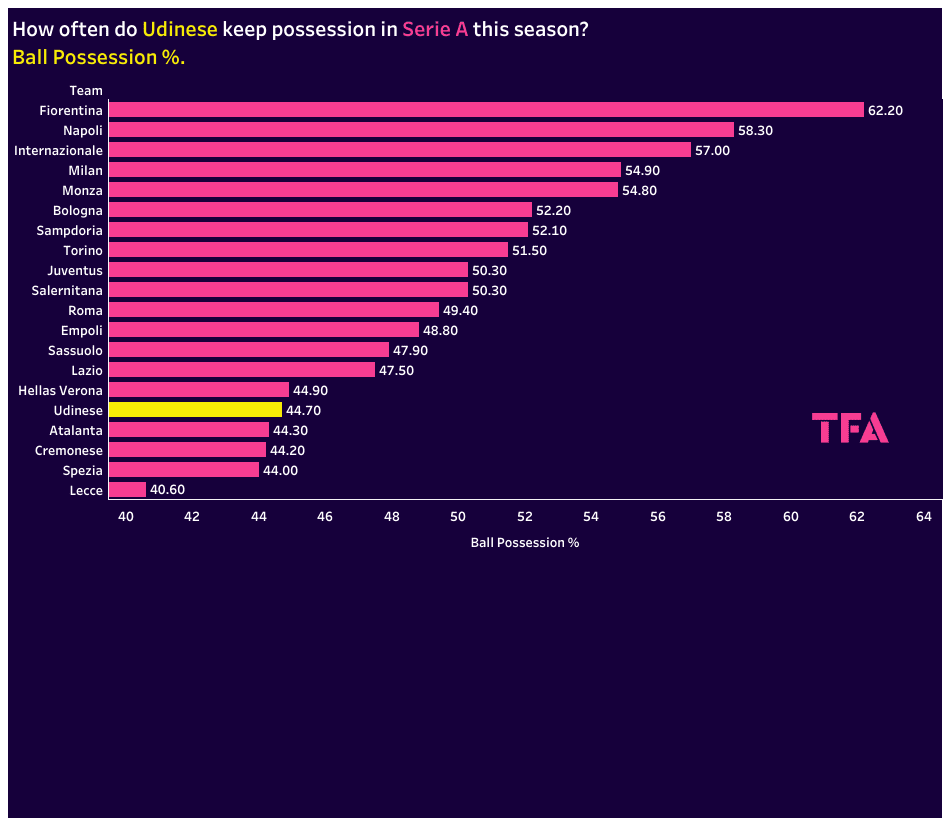
Udinese does not refrain from keeping possession when the opportunity arises. It is just that Sottil’s tactics require them to be quick and decisive in transition, therefore it brings a greater risk of losing possession. When they do hold possession their attacking style is varied and is not specific to a certain type of attack, they will go long, sometimes they will retain possession and build their attacks. The one common trait of their attacking approach is they like to get the ball in the attacking third quickly.
Build-up phase
The same tactics apply during the build-up phase. Udinese alternate between two separate ways of building up. Sometimes they will go long directly from the goalkeeper and sometimes they will play out through the defence.
Both build-up styles bring a common trait. Whether it be long or through the defence, they focus on playing through the wide areas. Beto is the aim for the long ball, and he positions himself in the wide channel and becomes the focal point. The aim of this is to get the team higher up the pitch.
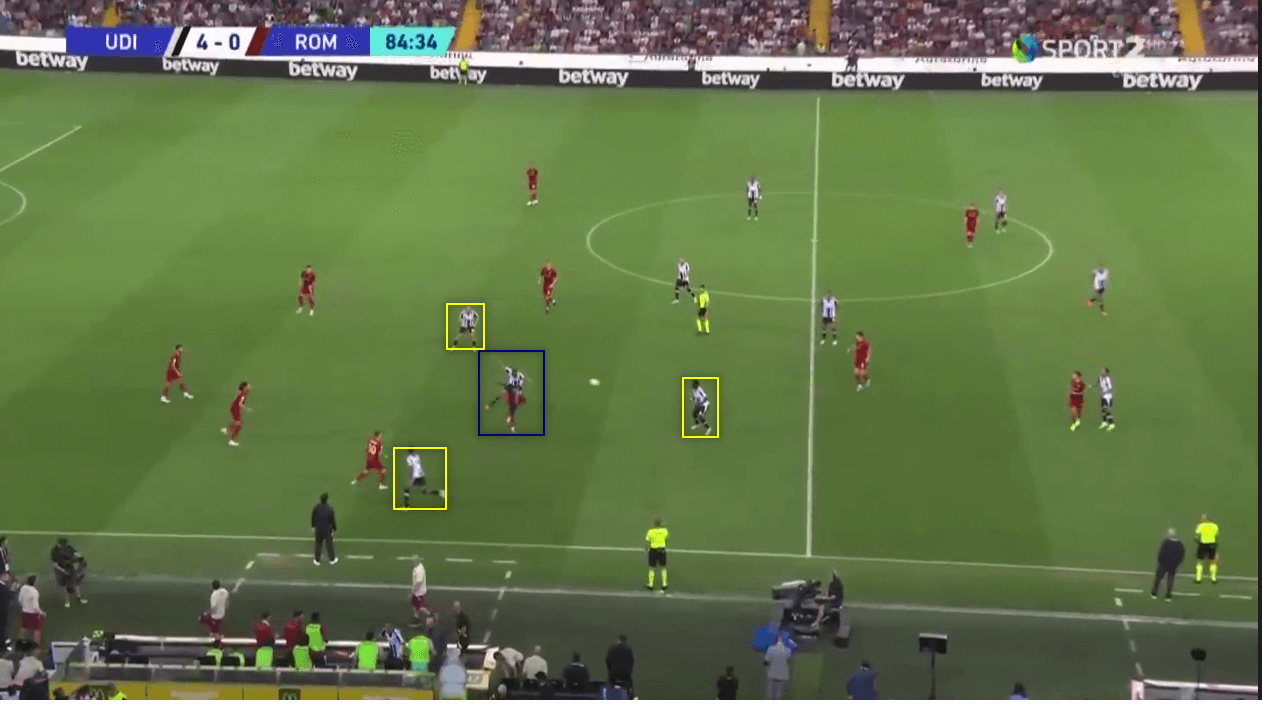
When they play out through the defence, they work the ball out wide, and they tend to play out through the right-hand side more. The three central defenders shift across to allow the wing back to push higher up the pitch.
The structure they follow enables them to overload the right-hand side, this pulls Roma’s players towards the ball. This build-up phase acts as a decoy because once Udinese get into the position they are in below, they then look to switch the ball to the left-hand side.
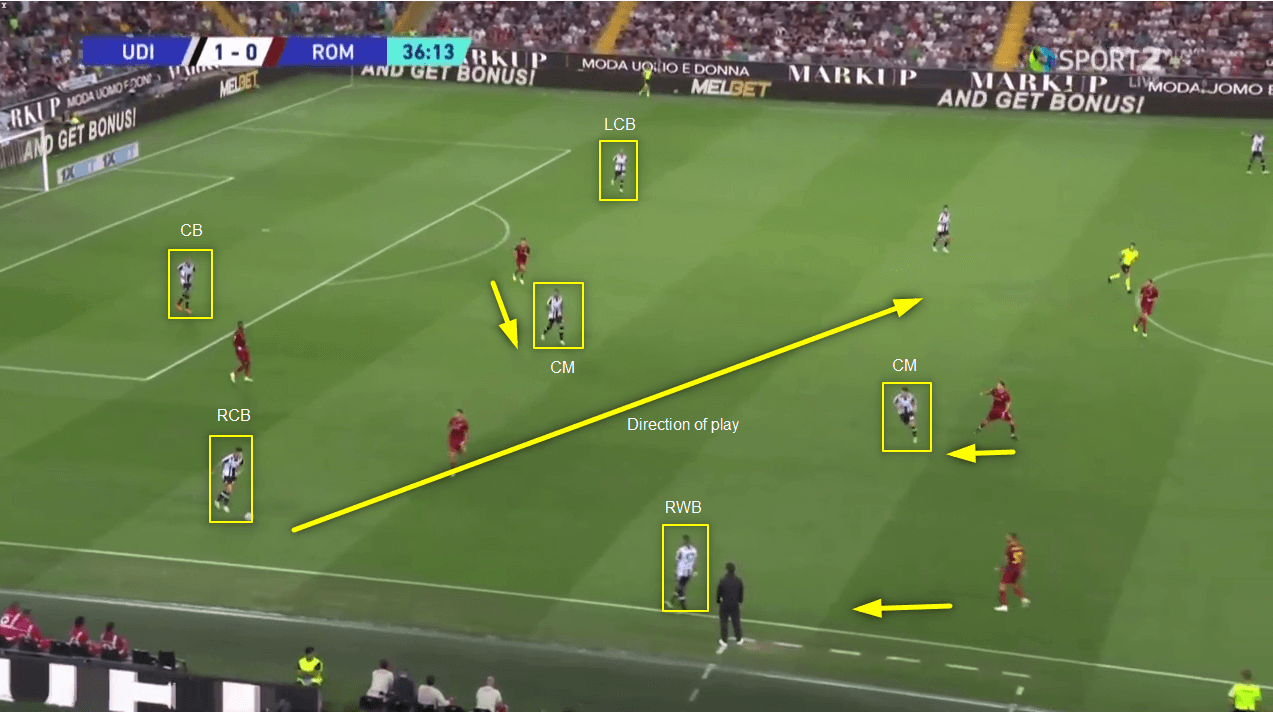
The overload drags Roma away from their defensive shape and over to that side of the pitch, leaving more space on Udinese’s left hand side for them to switch the ball to.
Middle Third
The nature of Udinese’s tactics under Andrea Sottil means they do not spend too much time attacking from the middle third. This is because they do not look to retain possession in this area of the pitch.
Instead, this part of the pitch acts as a starting point in Udinese’s attacking transition. In possession, Udinese will play passes into space for players to run onto and attack. Once the ball is played into the middle third the movement from this area is crucial to how Udinese succeed in the attacking third.
This example below shows Roberto Pereyra as the ball carrier as Udinese build down the right, look at the movement from the two forward players and two of the centre midfielders. Immediately focused on attacking the space in Roma’s half.
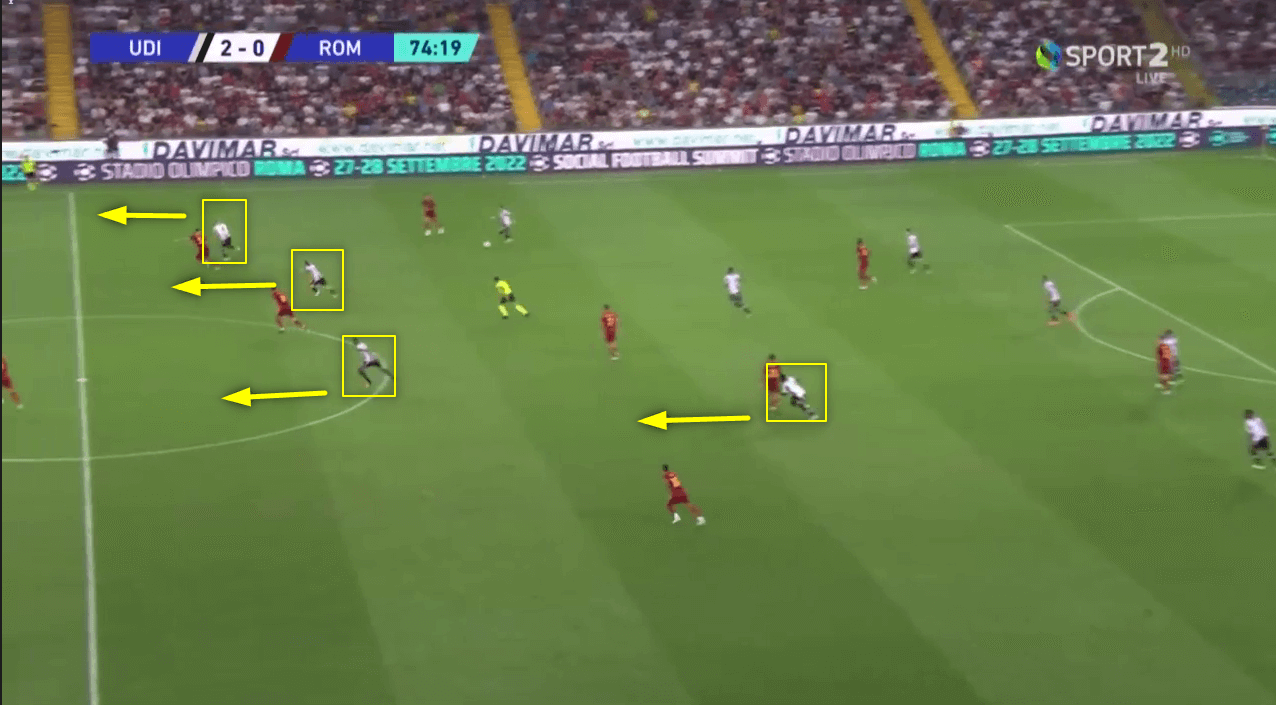
Attacking Third
Udinese’s attacking play in the final third is coy and more structured compared to their other phases of play. When they attack the opposition’s penalty area, they attack with good rotation and movement, and they show more patience in possession
Beto plays as the focal point that the other plays will rotate their position around him, and he will hold his position centrally. Gerard Deulofeu, who plays as a centre forward alongside Beto, will move from the attacking line and roam around the attacking third, he has been key to how Udinese attack this season. His movement between the lines in the image below enables Walace and Tolgay Arslan to make runs into the space he vacates. This type of movement is hard to defend as it happens in a split second the centre-backs will momentarily forget what space to cover.

The example shows the Udinese attacking shape as they enter the attacking third. The wing-backs joining the attacking line and playing as high as they do is fundamental to the attack even if they just function as a decoy. It allows Udinese to overload the opposition defensive line and stops the defence from sitting in a compact shape as it stretches them laterally.
Overall Udinese attacking efficiency has been positive before this first international break. The first seven games of the season have seen them score fifteen goals which is the joint highest amount with Napoli, they are averaging 1.97 goals per 90 minutes which is the highest in Serie A, just ahead of Napoli who are averaging 1.96 goals per 90.
What might concern Andrea Sottil moving forward will be the expected goals ratio Udinese are achieving. Although they have scored fifteen goals, their xG is only 9.59. This means they have scored more than they should have based on the quality of chance they are creating.
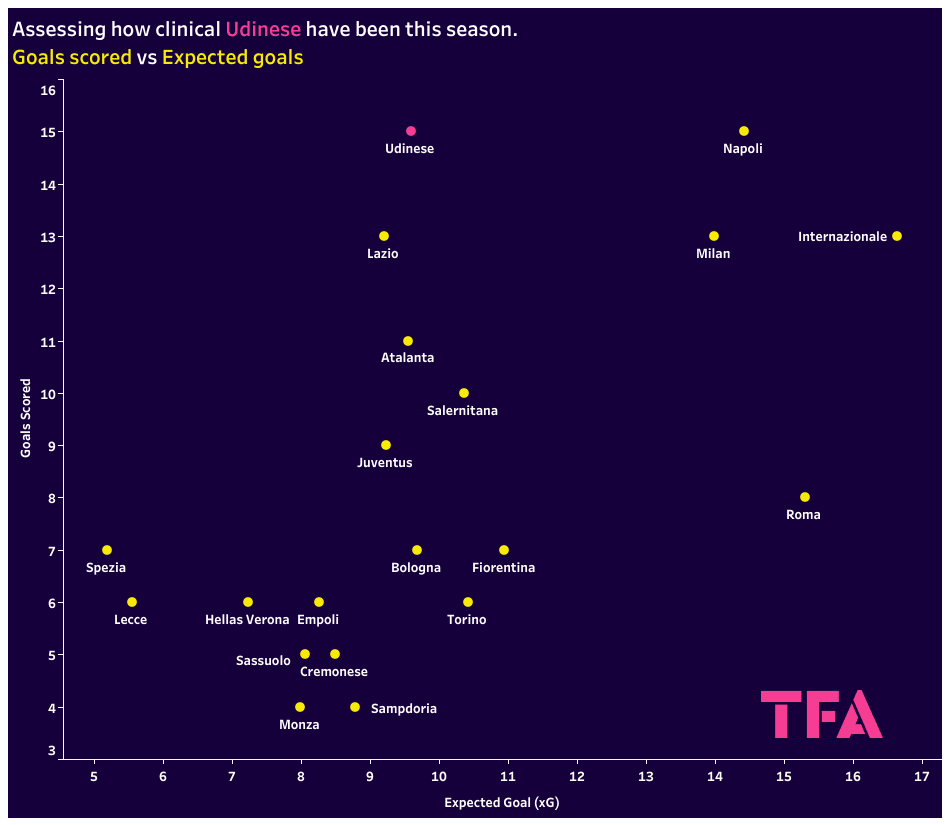
Defensive Stages
The reason Sottil has started the season playing the 3-5-2 formation is for defensive solidity when they are out of possession. The 3-5-2 formation transitions to a 5-3-2 defensive shape when playing against the ball. This allows Udinese to be difficult to break down as the defensive shape naturally allows them to protect the pitch centrally and force the opposition out wide.
Udinese allows their opponents to have the ball, but they try and control the space the opposition can pass to by forcing them into certain areas before attempting to win the ball back.
Rather than pressing the opposition in pursuit of the ball, Udinese’s defensive tactics are to block the passing lanes that surround the ball carrier and close the space in front of the ball carrier.
The data analysis below measures the number of passes that Udinese allows their opponents to make before performing a defensive action (PPDA), against how many duels tackles and interceptions they make per minute of their opponent’s possession (challenge intensity). This data shows us how active Udinese are in the pursuit of the ball.
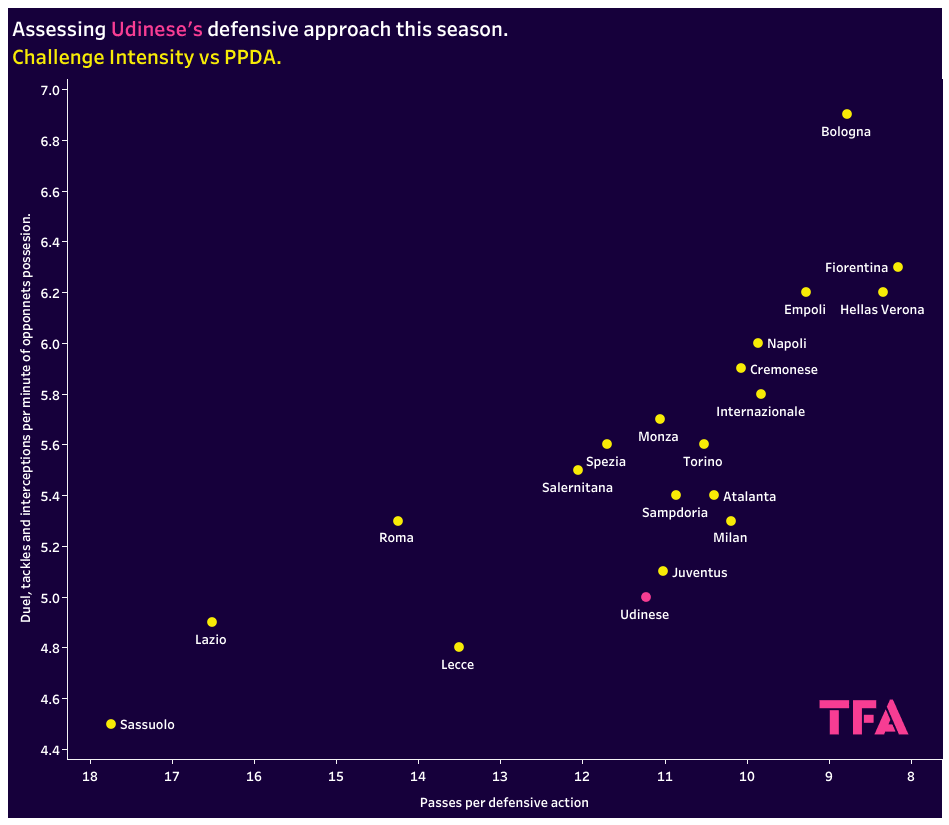
Udinese have the fourth-lowest challenge intensity in Serie A this season and allow the opposition the seventh-highest number of passes to be made before engaging them in a press.
Rather than pressing the opposition, Sottil wants Udinese to retain their defensive shape and not actively engage in winning the ball back until the right moment.
Low Block
Because Le Zebrette keeps their defensive shape, their defensive block can change situationally throughout a match. As they will look to keep minimal space between each position both vertically and laterally, they move as one defensive unit.
The image below shows how they defend in a low block. A defensive 5-3-2 shape with each central midfielder man to man with a Roma player in midfield. Udinese will still put pressure on the ball as Gerard Deulofeu is, but his run to block the passing lane into Bryan Cristante.
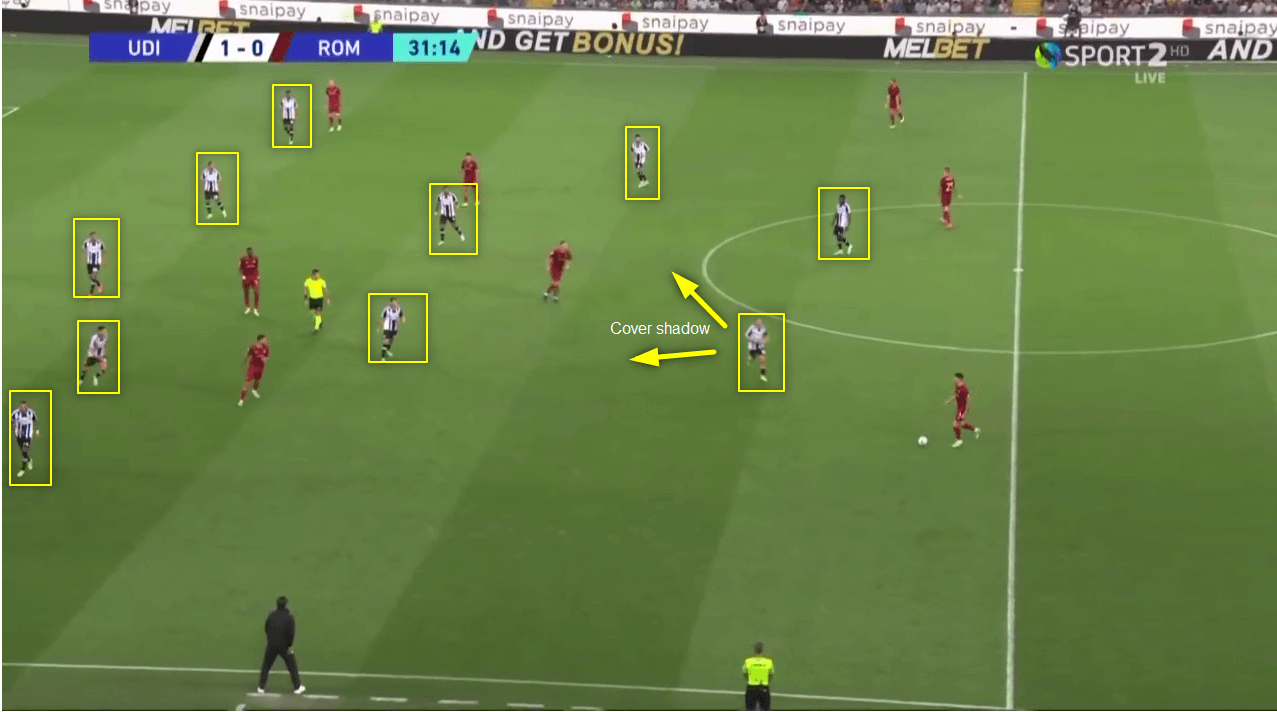
As you can see, Roma’s centre-back Ibañez cannot make that pass into Cristante because of Udinese’s defensive positioning.
Udinese’s shift through each defensive block is triggered when the other team passes the ball back into their own defence. Which usually comes from the ball being played into the wide channels. This is when Udinese press with the intent of winning the ball
Mid-Block
When they move into a mid-defensive block in the middle third of the pitch, their defensive shape changes from a 5-3-2 to a 5-2-3. The same defensive method applies; it is just that one of the central midfielders will move to the right or left of the attacking line.
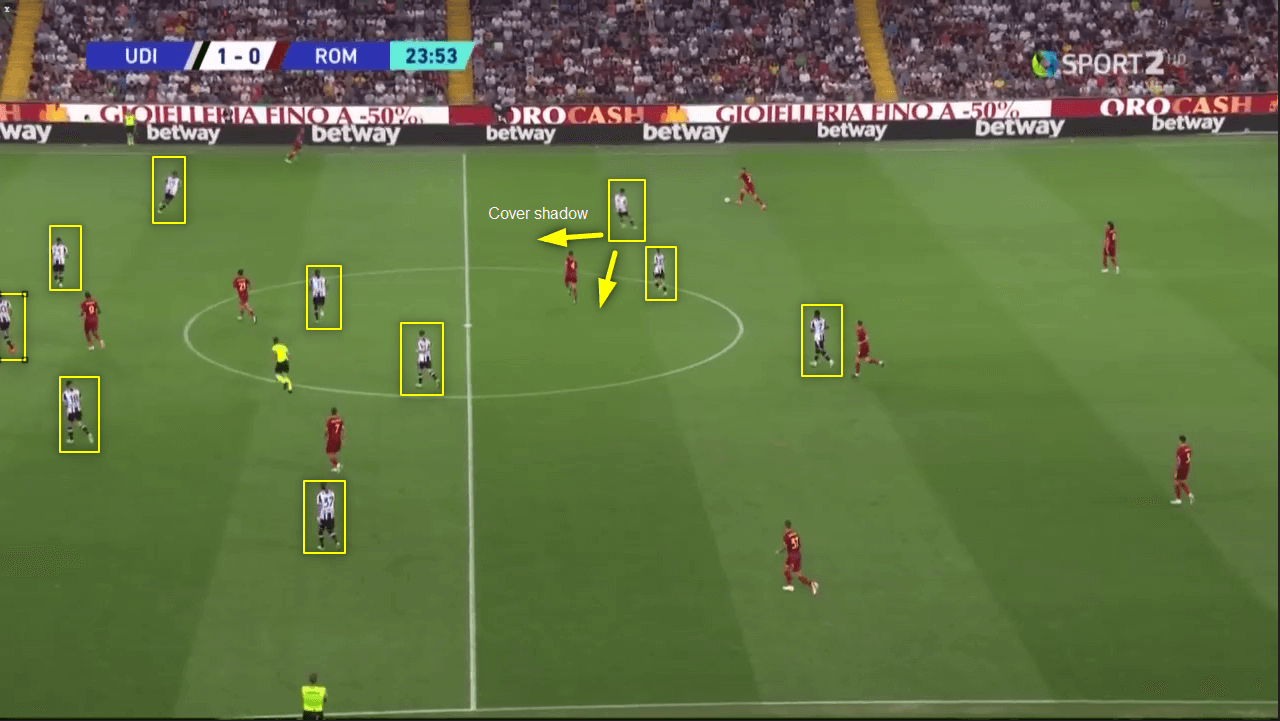
This enables the two centre-forwards to stay central and keep their shape. They still aim to cut the passing option off into midfield as they do above only now because they moved higher up the pitch. It is at this point Udinese start to try and funnel the play and force the opposition into a specific area.
Udinese’s preferable defensive block this season would be a mid-block, which enables the team extra space for the attacking transition when possession is won and if they are successful in forcing the play backwards instead of winning it, it forces them back into their half.
High Block
The image below shows how Udinese defend high up the pitch. When they defend high up the pitch, the system is deployed with one player pressing the space in front of the ball-carrier set-up, only this time, the 5-2-3 or 5-3-2 defensive formation is dependent on the number of players the opposition has during their build-up.
So, Udinese looks to apply a man-to-man pressing system and control the space. This example shows how the team from Friuli-Venezia Giulia box Roma into a specific area, the only way José Mourinho’s men get out in this situation is by playing a long or conceding possession
They have shifted over to the left to condense the space horizontally and pushed right in to close the space vertically.
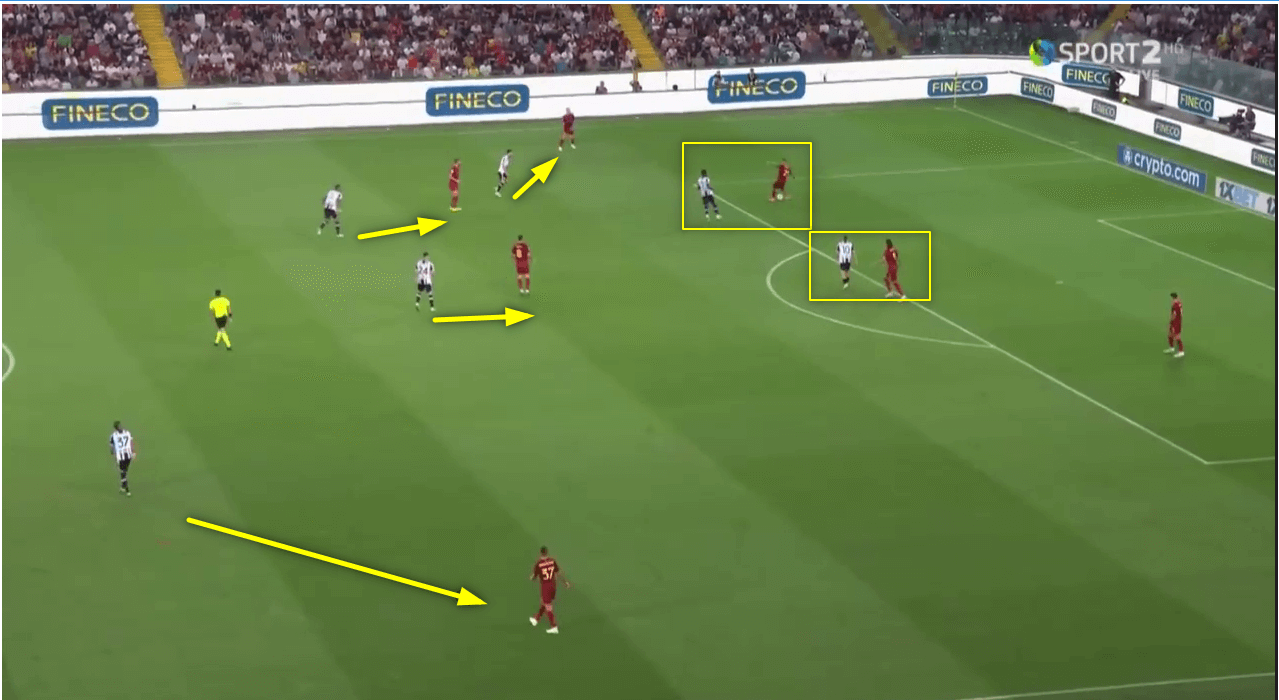
Conclusion
This is a tactical analysis in the form of a scout report that focuses on Udinese’s tactics this season, and what impact they have had on their positive start. We have covered each phase of play both in and out of possession and have provided data analysis to help give another layer to the tactics that Andrea Sottil has implemented since taking control this summer.

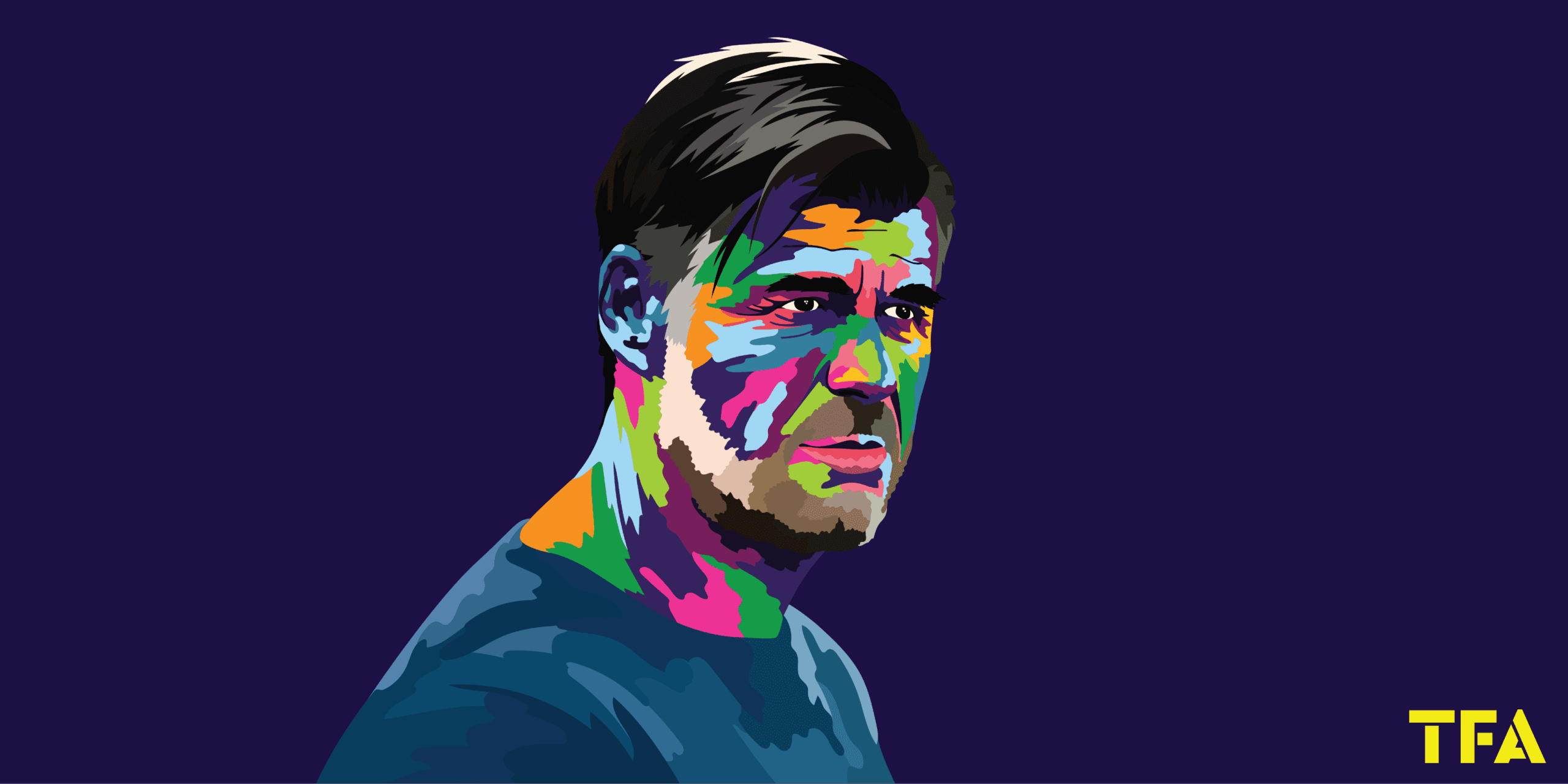




Comments